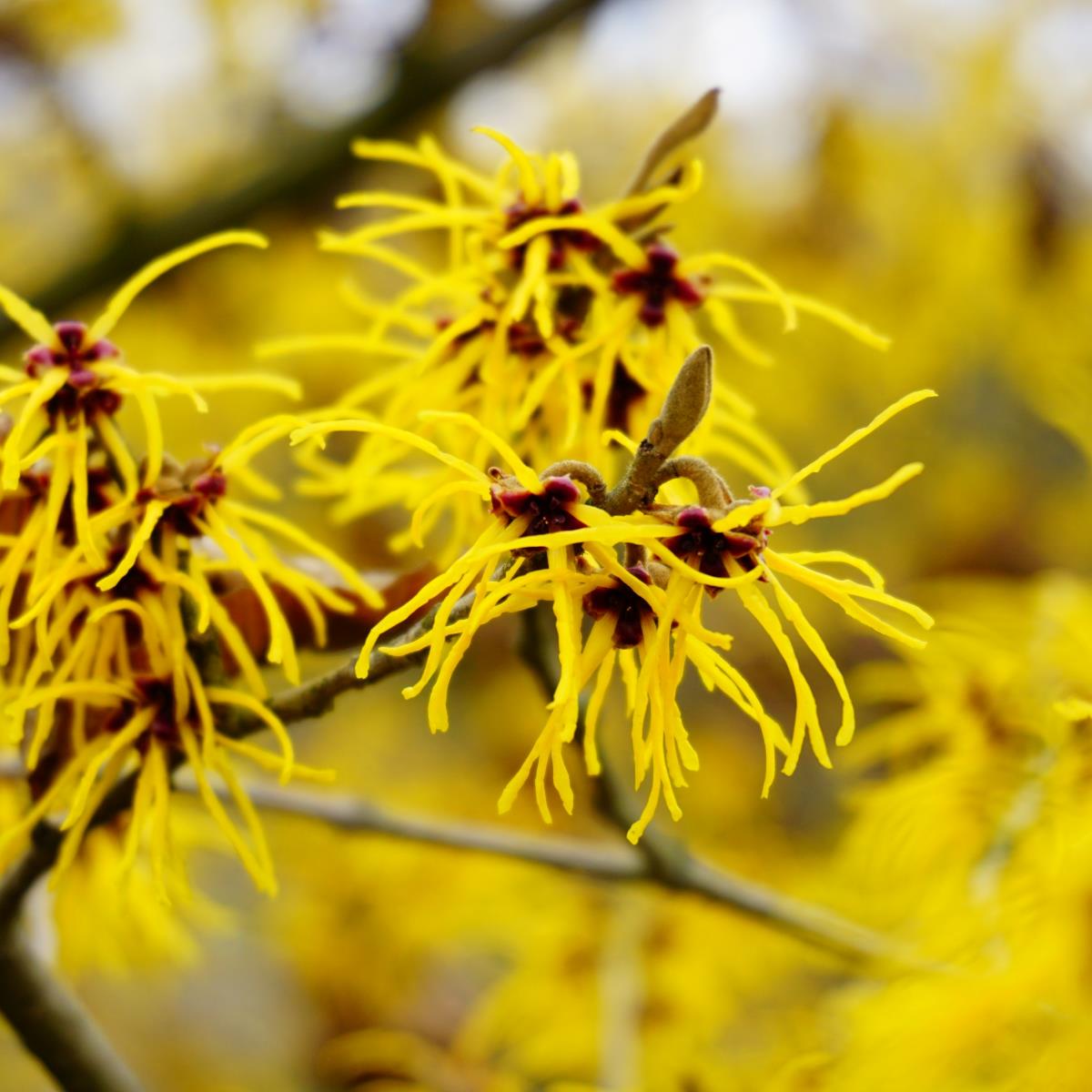Hamamelis
Witch Hazel
Overview
| Plant Type | Deciduous shrub / small tree |
| Hardiness Zone | 5-8 |
Cultivars
| Cultivar | Height | Spread | Blooms | Sun | Planted |
| Virginian Witch Hazel Hamamelis virginiana  | 15-20' | 15-20' | Fall & Winter | Full Sun, Partial Sun, or Shade | North of driveway, near raised berry garden |
Witch hazel is a fascinating and versatile plant with a long history of medicinal and cosmetic uses. It has been used by Native Americans for medicinal properties, including as a natural remedy for skin irritations and wounds. It has also been used for: hemorrhoid relief, sore throat relief, and as an anti-inflammatory.
Ongoing Management
Planting
Best grown in average, medium moisture, well-drained soils. Prefers organically rich, moist, acidic (pH 4.5 - 6.5) soils. Tolerates heavy clay soils.
Naturally found along stream banks in the shade in its native range, where it appears open and poorly branched. However, under cultivation in full or partial sun, it develops a fuller, rounded crown.
Insect & Disease Control |
|
May be damaged by rabbits and deer. Keep an eye out for honey fungus, phytophthora root rot, coral spot, and powdery mildews.
- Honey fungus (Armillaria mellea) - a fungus which attacks a wide variety of trees, travelling underground to infect the roots of one tree from another and eventually impregnating the area under the bark of the trunk. When honey-coloured toadstools appear around the base of the tree, it is partially infected and should be burned together with its roots and branches. There is little chance for a cure, but in some early stages some chemical control may be possible.
- Bootlace fungus (Armillaria tabescens) is similar to honey fungus, but grows only on the trunk of deciduous trees.
- Phytophthora root rot - a condition often caused by excessive watering or water-logged soil, but may also be the result of attack by several kinds of disease organisms such as fungi.
- Coral spot fungus (Nectria cinnabarina) - Coral spot is a disease of woody plants caused by the fungus Nectria cinnabarina. It can infect and cause disease in any woody shrub or tree, but it is most common on: Hazel, Beech, Hornbeam, Sycamore, and Chestnut.
- Powdery mildew - a white powdery fungus grows on the upper leaf surface of the lower leaves. Leaves may be twisted, distorted, then wilt and die.
More information is in the links below.
Fertilization |
|
Light fertilization in the Spring is OK; however do not fertilize in the Fall as it can encourage new growth that is vulnerable to Winter damage.
Pruning / Cutting Back |
|
No pruning is required, however cultivation helps develop a fuller, rounded crown.
Prune in late Winter or early Spring before new growth appears.
Integrated Pest & Pollinator Mgmt Notes |
|
Witch hazel provides a great source of pollen for the pollinators in the late season.
Propagation |
|
There are 3 ways to propagate:
- Seeds: Propagate by seed in a cold frame as soon as they are ripe, or by layering in Fall. Collect seeds from ripe Witch Hazel in the Fall.
- Layering: in late Winter or early Spring, select a branch that is low to the ground and partially bury it in the soil. Leave the tip of the branch exposed and secure it in place with a U-shaped stake. Keep the soil moist and wait for the branch to form roots. Once roots have formed, cut the branch from the parent plant and transplant it to its permanent location.
- Hardwood Cuttings: in mid-Spring, take 8-12 in cuttings from a healthy branch and remove the leaves from the bottom half of the cutting. Dip the cut end in rooting hormone and plant it in a well-draining soil mix in a container. Keep the soil moist and the container in a cool, shaded area until roots have formed. Transplant to the cutting to its permanent location.
The important key is to provide consistent moisture and the right growing conditions to encourage healthy growth and encourage development.
More Information
Books and Papers
- Ball RedBook 19th Edition Volume 2, by Jim Nau (635.9 NAU 2021).
- The Gardener's Dictionary of Horticultural Terms, by Harold Bagust (635.03 BAG 1992).
Web Sites
- Coral Spot Fungus
- Honey fungus
- Phytophthora root rot
- Powdery mildew
- Virginian Witch Hazel (Gardenia.net)
- Witch Hazel: Plant Care and Growing Guide (Gardenia.net)
|
eMail comments to me at GardeningBoK @ Gmail.com. |
